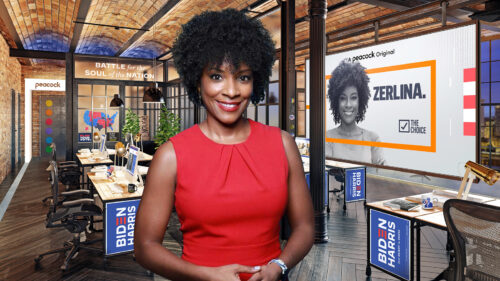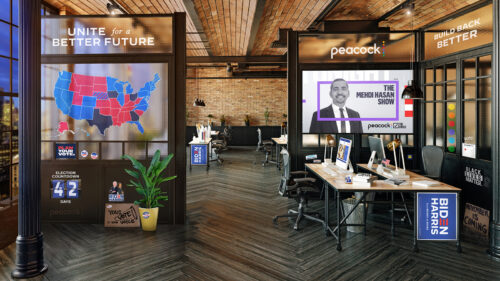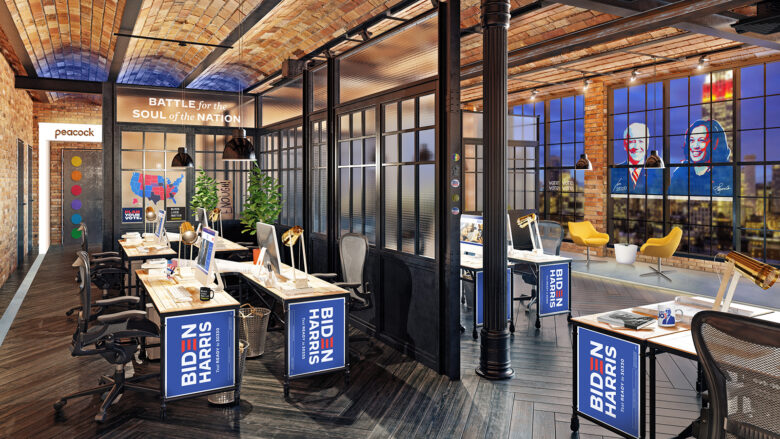A Q&A with Christine de Witte on NBC’s ‘The Choice’ and the Field of Virtual Backgrounds
New York, NY
2020
October 5th, 2020 marked the launch of two new NBC Universal programs: Zerlina, hosted by Zerlina Maxwell and The Mehdi Hasan Show. Both shows are affiliated with the network’s brand news streaming service ‘The Choice”. The NBC team turned to us in order to mind meld a thoughtful solution that mixed the use of virtual backgrounds, broadcast studio design, and corporate interior design. Veteran Clickspring Design Director Christine de Witte, alongside Chief Creative Officer Emmett Aiello spearheaded the project bringing all sides a success. We interviewed lead designer Christine de Witte to dive further into the specifics of the project and the future of virtual backgrounds in broadcast.
CSD: Tell us a little bit about the original ask from NBC.
CdW: NBC came to us in September describing a new show that would launch on Peacock in three weeks, specifically left-leaning, election analysis content – they knew the talent (possibly still working remotely) would be using a greenscreen and then keyed into a virtual background, so they asked us to help define that environment.

CSD: What was the desired outcome of the designed space? / What became our design intent?
CdW: We aimed to create a virtual space that feels like an authentic workplace: less polished but still aesthetically related to some of our other NBC work (like the Level 4 Newsroom, for example). After kicking around thematic suggestions, we landed on “campaign headquarters in a reclaimed building” – this provided the impetus to incorporate visually tactile materials like brick, wood, and aged steel, while simultaneously allocating areas to overlay media content (ie – building virtual LED screens). A final guideline was that we wanted the space to communicate through ‘found elements’ – items the “staffers” had brought in to adorn their workspaces would help set the tone for the environment.
CSD: What were some of the biggest differences in workflow from a typical 3D project?
CdW: The biggest difference is that this entire design was executed in Photoshop. The project’s quick timeline and limited budget were factors, but ultimately the desired deliverable drove our approach. Usually, our goal is to build a physical space, so we model in 3D to inspect and control every possible angle of the design. This time, our final deliverable would be two high-res images, so it made sense to shortcut some of the “build” process by finding stock images of a space that generally felt right, and then customize to our needs via Photoshop editing. These edits, depending on their magnitude, require really careful attention to scale, perspective, and shading in order to maintain believability – that’s something 3D models automatically resolve, so it’s good practice to do manually on occasion.
CSD: You were asked to redefine a purchased-image space from a day-look to evening-look, can you tell a little bit about that process?
CdW: Ha, yes, that was one of the challenges – we found images of a space that, generally, really resonated with our desired aesthetic, but the stock images featured daylight that was so strong the exterior view wasn’t even visible, and many of the interior surfaces were washed in light. Knowing that we wanted an evening look meant not only masking out the windows and mapping a night-time view, but also reconstructing many of the metal, wood, and brick textures so that they weren’t reflecting full sunlight.There were a few other specific requests, too, like moving a wall partition forward or replacing a workstation group with soft seating, that would’ve been so simple in a 3D model but were a huge undertaking in Photoshop – definitely made me question the process once or twice, but in the end, and limited to two views, this route was still more efficient.

CSD: What was the anticipated timeline for this project?
CdW: We first heard of it 3 weeks before launch, spent a few days on initial discussions and (together with the client) determining an overall direction, quickly put together some rough comps for the camera testing, and then spent another week on meticulous Photoshop work. That landed us with the delivered concepts, and the client’s graphics team made final edits according to the director’s wishes before launch.
CSD: Can you point out some of the personal touches throughout the design
CdW: Sure! Since we were aiming to include a variety of ‘found objects’ to help define tone, it was easy to have a little fun with some of the Photoshop elements. I placed a patriotic Snoopy on one of the desktops as an easter egg for the client who is a Snoopy fanatic … and I personally drew the “Your Vote is Your Voice” sign, so my handwriting is now officially on air. All political affiliation was neutralized in the end, so few of my favorite elements that didn’t make the final cut include a “cup o’ Joe” coffee mug, Obama’s newly released book A Promised Land, and the stylized Joe + Kamala window applique.

CSD: Do you have any other opinions on industries moving towards virtual backgrounds? Or any other thoughts on this specific project?
CdW: I think it’s inevitable that we see more and more virtual backgrounds and entire virtual sets. One exciting or freeing aspect is that pixels can do virtually (pun intended) anything and cost nothing – we’re not subject to gravity, material properties, or construction costs. That being said, I think it’s great when a client recognizes they still benefit from consulting us to create a believable, communicative space. As we’ve all learned via Zoom these past months, it’s easy to swap out a digital background, but it takes expertise to design something that feels almost as real or meaningful as a built environment.
